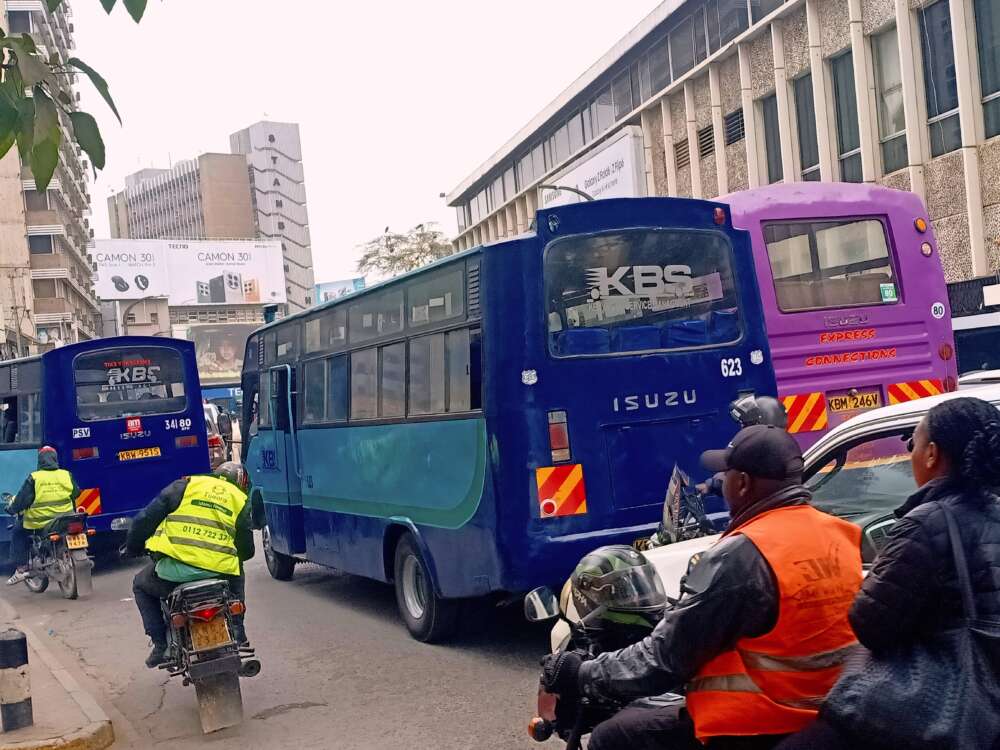By Polly Gitau, DevReporter, Nairobi County

Key Highlights
- Kenya’s public transport business has expanded rapidly, becoming one of the major contributors to the country’s economy.
- Kenyan public transport sector has remained under the control of private investors, which has introduced numerous challenges for the Kenyan public.
- The code of conduct also aims to establish guiding principles for interactions with passengers.
Kenya’s public transport business has expanded rapidly, becoming one of the major contributors to the country’s economy. This sector witnesses a daily increase in the number of public service vehicles.
According to a report by Changing Transport, the transport and services sector accounts for 8.3% of the country’s Gross Domestic Product (GDP).
Article 43 of the Kenyan Constitution addresses economic and social rights. While it does not explicitly mention public transport, it underscores the necessity for access to essential services, which should include a safe, available, and affordable public transport system as part of realising these rights.
Public transport should ideally be funded through citizens’ taxes, as seen in some developed countries; however, this is not the case in Kenya.
Instead, Kenya’s public transport system is operated by businesspeople, who purchase vans and buses, registering them under licensed saccos to serve transport routes as public service vehicles.
This gap was created when former political regimes permitted private investment in the sector.
Need to Meet Transport Demands
The private ownership of public transport vehicles emerged from the need to meet transport demands in certain areas, such as Nairobi’s Eastlands, during colonial times.
At that time, the colonial government enforced restrictions that limited public transport to a select group and specific routes, leading to the rise of matatus in the mid 1950s.
Since then, the Kenyan public transport sector has remained under the control of private investors, which has introduced numerous challenges for the Kenyan public.

Unregulated Profit-driven Environment
Titus Kaloki, Programme Coordinator of the Just Cities and Politics Programme at Friedrich Ebert Stiftung (FES), highlights that Kenya’s public transport system operates in an unregulated profit-driven environment that prioritises profit over service to the people.
Kennedy Onyancha, a resident of Nairobi, expresses his concerns about the deficiencies in the Kenyan public transport system.
“Public Service Vehicles (PSVs) play a critical role in the country’s economy, but there are gaps, particularly concerning fares. Currently, fares are not capped, resulting in various saccos taking advantage of peak and off-peak hours, leading to differing rates throughout the day. As a consumer, I want to avoid feeling exploited; therefore, fares should be capped at an affordable level.”
Public Transport Code of Conduct
Titus Kaloki explained that FES focuses on ensuring social democracy is entrenched in societies to achieve social justice.
FES was involved in the drafting of Kenya’s public transport code of conduct. It has been collaborating with local partners in Kenya who address issues related to democracy, governance, labour, and access to public goods and services, by supporting them in implementing projects centred on these themes.
Through its involvement in urbanisation, FES recognised an increasing demand from partners in urban areas for access to public goods and services.
It became clear that public transport is one of the most urgent and politically sensitive issues to tackle, as the majority of urban residents, particularly young people and people from the marginalised areas like slums, depend on it.
Through its partners, including the Kenya Young Parliamentarian Association and an Alumni of their Young Leadership Programme, public transport issues have been addressed by engaging with the National Transport and Safety Authority (NTSA) and Nairobi County leadership.
Together, they developed a draft of Kenya’s Public Transport Code of Conduct through a consultative forum, intending for the NTSA and Nairobi County to use it to create a legally binding code of conduct for public service vehicles and enforce it.
Evident Gaps
Though the Kenya Public Transport Code of Conduct was launched in 2021 to promote safety and professionalism within the public transport sector, there are noticeable gaps between its provisions and current practices observed in Nairobi.
Samuel Musumba, Safety Programme Manager at NTSA, acknowledged the need to enhance efforts in raising awareness of the public transport code of conduct.
One of the objectives of the code is to uphold values and set behavioural standards for saccos, their crews, and partners, in order to achieve a socially just public transport system.
The code of conduct also aims to establish guiding principles for interactions with passengers.
However, incidents of misconduct, harassment, and unprofessional behaviour among public transport workers are common on the streets of Nairobi, creating a troubling norm.
This chaos in the public transport sector raises questions about whether those involved are aware of the code of conduct.
Do passengers, who often experience violations and harassment, know their rights?

Albert Jacob, a photographer who commutes to Nairobi daily for his work, admitted that he was unaware of the public transport code of conduct prior to our conversation.
“This is my first time hearing about the code of conduct. They could educate the public by posting printed versions in PSVs so that everyone is aware. If someone is caught in the wrong, it would be easier to understand what they have done wrong.”
Joseph, a Nairobi resident, although somewhat hesitant to speak with this reporter, expressed that he is aware of the code.
“Yes, I know about the public transport code of conduct, but to improve the situation, we need to educate the public because most people are unaware of its existence. When the public is informed, individuals will have the confidence to defend themselves against harassment or violations.”
Need for Intervention
According to Samuel Musumba, there is an urgent need for intervention to effect noticeable change in the Kenyan public transport sector.
He outlined proposed actions to bridge the awareness gap regarding the public transport code of conduct.
“We are now advocating for saccos to develop their internal safety policies. One of the key areas we will focus on is the public transport code of conduct. With the support of FES’ Political Leadership and Governance Programme (PLGP), we now have a document that is fairly clear and simple. We will reach out to the saccos and companies, to encourage them to adopt this improved version, as what we currently have is not as comprehensive.”
Foster Collaboration
The aim of implementing internal safety policies within saccos is to foster collaboration within the industry, among regulators, law enforcers, and industry players.
As required by the NTSA, during the licensing of the saccos under which all public service vehicles are meant to operate, the saccos must provide their developed code of conduct for review by the NTSA. This review is mandatory before they can be allocated a licence to operate.
However, this licensing system is heavily flawed, as for many of these saccos, the code of conduct serves merely as a compliance document that is subsequently tucked away after licence registration, according to Samuel Musumba.
He noted that there is insufficient monitoring to ensure the saccos implement the code of conduct, which contributes to the disorderly nature of public transport.
“We need to work together. We are moving away from the old paradigm where the regulator is on one side and the operators on another, creating an appearance of conflict. Whenever we conduct basic enforcement, these operators hide their vehicles, making it seem like we are in opposition,” said Samuel Musumba.
Findings from the Socially Just Public Transport Working Group, hosted at the Institute of Development Studies at the University of Nairobi, indicate that the government has struggled to engage with public transport investors in a meaningful way, hindering their capacity to provide equitable services.
Titus Kaloki highlighted that the relationship between the government and public transport industry players is not cordial.
He characterised it as more antagonistic, focusing on regulation rather than empowerment, which often leads to a lack of voice for stakeholders.
He explained that whenever the government attempts to intervene in the sector, its efforts are not respected.
According to him, the government’s voice is weak because it does not build capacity, making it challenging to formulate sustainable policies.
“That is why every time the government tries to remove matatus from certain areas, it fails, as it has not engaged meaningfully. Its voice is not heard, and the policies they propose are top-down, one-sided, and unresponsive to actual needs,” Kaloki stated.






